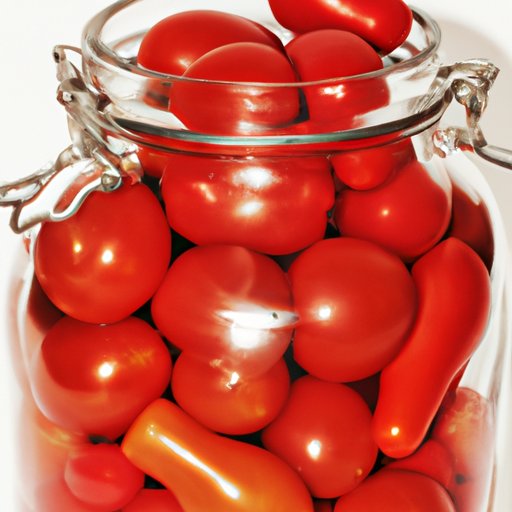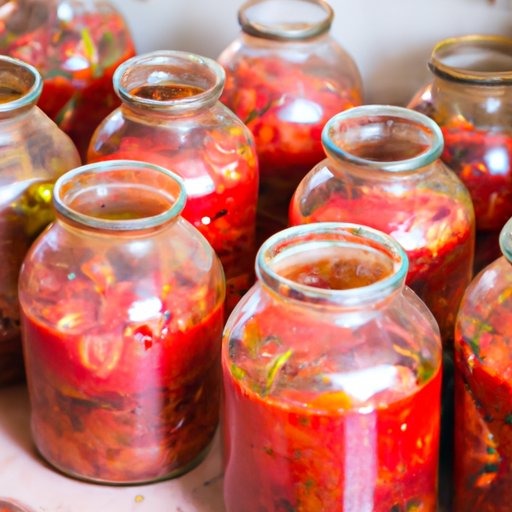I. Introduction
Preserving tomatoes is an essential skill for any home cook or gardener. These versatile fruits are delicious in everything from homemade pasta sauce to salsa. But as with any harvest, tomatoes are only in season for a short time, making it vital to know how to preserve them for later use. Not only does this ensure that you always have fresh tomatoes on hand, but it also helps to reduce food waste. This article will provide a complete guide to preserving tomatoes, including the different methods, best practices, troubleshooting tips, and more.
II. How to Preserve Tomatoes: A Complete Guide
Preserving tomatoes is a useful skill to have, whether you grow them yourself or purchase them from a local farmer’s market. The process of preserving tomatoes involves preventing the growth of bacteria and mold, which can cause them to spoil quickly. This can be done through various methods, including canning, freezing, and drying. Each method has its own benefits and drawbacks, so it’s essential to choose the one that works best for your needs.
Before we dive into the different methods of preservation, it’s important to know how to choose and prepare your tomatoes. The best tomatoes for preservation are ripe but firm, with no visible signs of decay. When preparing tomatoes for preservation, be sure to remove any stems or cores, as well as any blemishes or bruises.
III. Top 7 Ways to Preserve Tomatoes for Later Use
There are many ways to preserve tomatoes, but some methods are more popular and effective than others. Here are the top seven ways to preserve tomatoes:
- Canning
- Freezing
- Drying
- Pickling
- Jamming
- Making tomato sauce
- Making tomato paste
Each of these methods can be used to preserve tomatoes in different ways. For example, canning is a great option for preserving whole or diced tomatoes in a flavorful sauce, while freezing is ideal for those who want to keep their tomatoes fresh for future use.
Canning
Canning is a method of preservation that involves cooking tomatoes in a jar at high temperatures to kill any bacteria that may cause spoilage. Here’s how to can tomatoes:
- Start by washing your jars and lids in hot, soapy water. Rinse them thoroughly and place them in a large pot of water to boil for at least 10 minutes.
- While your jars are boiling, prepare your tomatoes. Remove stems and cores, and slice or dice them as desired.
- In a large pot, combine your tomatoes with any desired seasonings, such as salt, sugar, or herbs. Cook them over medium heat until they are heated through, stirring occasionally.
- When your jars are finished boiling, remove them from the water and fill them with your hot tomato mixture using a canning funnel, leaving about 1/2-inch of headspace at the top of each jar.
- Clean the rims of the jars with a wet cloth, place lids on top, and screw on rings until they are only finger-tight.
- Process your jars in a boiling water bath for the recommended amount of time, usually 35-45 minutes, depending on the size of the jar and altitude.
- Remove jars from the water bath and let them cool on a towel for 24 hours. Check seals and store in a cool, dark place for up to a year.
Freezing
Freezing is a fast and easy method of preserving tomatoes. Here’s how to freeze tomatoes:
- Blanch your tomatoes in boiling water for 30-60 seconds, then transfer them to a bowl of ice water to cool.
- Peel your tomatoes and remove any cores or blemishes.
- Place your tomatoes into freezer-safe bags or containers, removing as much air as possible. Label and store in the freezer for up to 6 months.
Drying
Drying is a method of preserving tomatoes that involves removing the moisture from them. This can be done in the sun, in a dehydrator, or in the oven. Here’s how to dry tomatoes using an oven:
- Preheat your oven to 200 degrees Fahrenheit.
- Cut your tomatoes in half and remove the cores.
- Place your tomatoes on a baking sheet lined with parchment paper, cut-side up.
- Sprinkle your tomatoes with salt and any desired seasonings, such as garlic or Italian herbs.
- Bake your tomatoes for 6-8 hours, until they are completely dehydrated but still pliable.
- Allow your tomatoes to cool completely, then pack them in an airtight container. Store in a cool, dry place for up to 6 months.

IV. Tomatoes 101: Best Methods for Preserving This Beloved Fruit
Choosing the right method of preservation can depend on the type of tomato you’re working with, as well as personal preferences. Here are some tips for preserving different types of tomatoes:
Slicing Tomatoes
Slicing tomatoes can be preserved through canning, freezing, or dehydrating. Canned tomatoes are great for use in soups and stews, while frozen tomatoes work well in sauces and salsas. Dehydrated tomatoes can be added to salads or sandwiches for a burst of flavor.
Roma Tomatoes
Roma tomatoes are ideal for canning, as their firm flesh holds up well to heat. They are also great for drying, as they have a low water content. Roma tomatoes can also be frozen or pickled.
Cherry Tomatoes
Cherry tomatoes can be preserved through canning, freezing, or pickling. They can also be dried, although this can be tricky due to their small size. Cherry tomatoes are great for use in salsas and relishes or as a topping for pizzas and salads.
V. Avoiding Wastage: The Simplest and Most Effective Ways to Preserve Tomatoes
Reducing food waste is essential in today’s society, and preserving tomatoes can help accomplish that. Here are some ways to avoid wastage:
Using Excess Tomatoes
If you have more tomatoes than you know what to do with, try making tomato sauce, salsa, or jam. You can also cut them up and freeze them for future use. Tomatoes can also be used to make Bloody Mary’s, tomato soup, and tomato juice.
Pickling Tomato Scraps
You can also reduce waste by pickling tomato scraps. Simply collect the ends and extra pieces of your tomatoes and pack them into a jar with vinegar, salt, and spices. This will create a tangy and delicious condiment that can be used in many recipes.
VI. From Canning to Freezing: Essential Tips for Preserving Your Tomato Harvest
Preserving your tomato harvest can be a bit daunting at first, but with a few tips and tricks, it’s easy to master. Here are some essential tips for preserving your tomatoes:
Cleanliness is Key
When preserving tomatoes, it’s essential to keep everything clean and sanitized. This will help prevent the growth of harmful bacteria and fungi that can cause spoilage. Wash and dry all jars, lids, and utensils thoroughly before use.
Use High-Quality Ingredients
When making tomato sauce or salsa, use only the best ingredients to ensure the best flavor possible. The same goes for canning tomatoes; fresh, ripe tomatoes will yield the best taste and texture.
Follow Recipes Carefully
When canning or preserving tomatoes, it’s crucial to follow the recipe exactly. This ensures that the acidity and other factors are at the proper level to prevent spoilage.
VII. DIY Guide: How to Preserve Tomatoes in 7 Easy Steps
Here is a step-by-step guide to preserving tomatoes:
- Choose your method of preservation.
- Wash and prepare your tomatoes as desired.
- Follow your recipe carefully.
- Clean and sterilize all jars and utensils.
- Process your tomatoes using your chosen method.
- Store your preserved tomatoes in a cool, dark place.
- Enjoy your preserved tomatoes in your favorite recipes all year long!
VIII: How to Keep Your Tomatoes Fresh and Delicious All Year Round
Storing your preserved tomatoes properly is key to maintaining their flavor and quality. Here are some tips:
Temperature and Humidity
Stored tomatoes should be kept in a cool, dark place with a temperature range between 50 and 70 degrees Fahrenheit. Avoid storing them in areas that are too humid, as this can cause mold growth.
Choose the Right Container
The container you choose for storage will depend on the preservation method you’ve used. If you’ve canned your tomatoes, they should be stored in glass jars with airtight lids. If you’ve frozen them, use freezer-safe bags or containers.
Label and Date Your Containers
Labeling your containers with the type of tomato and the date of preservation can help you keep track of what you have on hand and ensure that you rotate your stock properly.
IX. Conclusion
Preserving tomatoes is a great skill to have as a cook or gardener. It ensures that you always have fresh tomatoes on hand, reduces food waste, and can provide a flavorful addition to various recipes. With the many methods of preservation available, from canning to freezing, there’s no excuse not to try it yourself.
